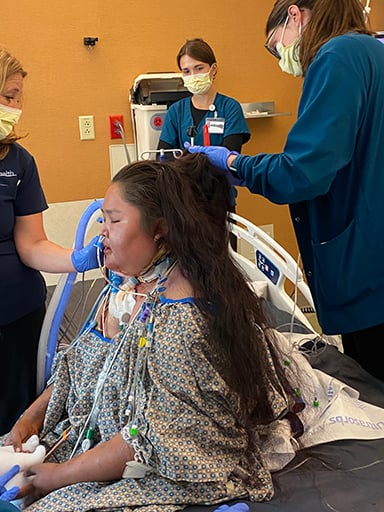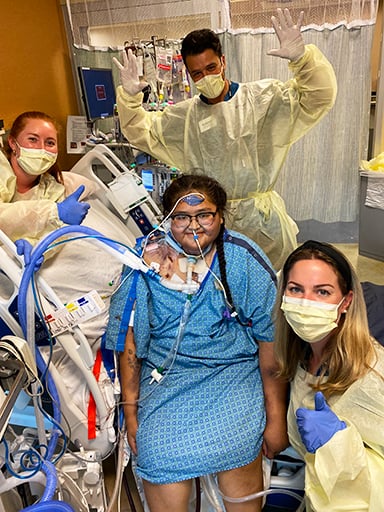With her favorite Taylor Swift songs playing in the background and her team of healthcare providers cheering her on, Chenille James stood up from her hospital bed. Her destination was just outside the door, her task a short walk down the hallway. But the feat would be celebrated for months to come.
Most patients requiring prolonged mechanical ventilation in Cardiothoracic Intensive Care Units (CTICU) – which treat some of the hospitals’ sickest patients – remain sedated and bedridden for the bulk of their stay, especially those as critical as James. The then-19-year-old’s mobilization last September was part of an ongoing effort to change that reality.

Chenille James' care team does her hair as she banks some bedside sitting time. |
“At every institution that I’ve worked in, regardless of the state or the country, sedation was the standard of care,” said Mikita Fuchita, MD, an assistant professor of anesthesiology in the University of Colorado School of Medicine at the CU Anschutz Medical Campus. “I knew it as normal,” said Fuchita, who specializes in critical care.
But during his fellowship in 2020, Fuchita began digging into the research behind sedation. Although long viewed as best for the patient, what he found was the exact opposite.
Sedation downfalls can outweigh benefits
“People give sedation out of compassion. They are not trying to harm patients,” said Fuchita, who surveyed over 100 CTICU staff members on sedation beliefs as part of a recently launched initiative at UCHealth University of Colorado Hospital called SOAR (Sedation Off, Awake, Rehabilitate).
In recent years, however, as more research emerges on the impact of ICU delirium and post-intensive care syndrome (PICS), both of which affect well over half of all ICU patients, evidence suggests the downfalls of deep sedation often outweigh the benefits.
“Patients who are exposed to sedation have a higher chance of anxiety, depression, PTSD and physical disabilities long after their ICU discharge,” Fuchita said. “There can also be a cognitive effect,” he said, adding that studies have found some ICU patients who experienced delirium during their stays having cognition scores equal to patients with mild Alzheimer’s or traumatic brain injury.
‘It’s the right thing to do for our patients’
After learning about a hospital in Utah that had stopped sedating patients as the standard practice years ago, Fuchita visited that ICU. “Seeing is believing,” said Fuchita, who said he doubted the patients were as sick as those treated in the UCH CTICU when he headed to Utah.

Keeping patients' spirits up is part of a new initiative to have them awake and mobile. |
“But their patients are actually very sick.” As in his own unit, many had ARDS (acute respiratory distress syndrome) and the highest amount of oxygen requirement, he said. “Yet their patients are awake, sitting in chairs, using laptops and iPhones and behaving normally. The only thing that was different from a non-ICU patient was they had a breathing tube.”
Thus, SOAR was launched in the UCH CTICU, where a dedicated and multidisciplinary staff has been successfully weaning select patients off sedation and mobilizing them early in their care.
“It’s the right thing to do for our patients,” said Catherine Mickey, RN, clinical nurse educator for the UCH CTICU, who believes the change in standard of care is poised to become a nationwide movement. “We are just on the front end of that change.”
SOAR’s mission, created through the team’s work with the university’s Institute for Healthcare Quality, Safety & Efficiency Improvement Academy, depends on a highly skilled and dedicated hospital staff.
‘Talking them down and reassuring them’
“It is more labor intensive,” said Mickey, part of the SOAR team that includes doctors, nurses, advanced-care practitioners and specialized therapists. “Certainly, as patients are waking up from anesthesia (after being intubated), they can have varying responses and need that ICU nurse right there. It takes really talking them down and reassuring them, rather than just starting them on a sedation drug.”
When patients wake up with a tube down their throats that gives them the sense they are “breathing through a straw,” they panic and want the tube out, Fuchita said. “And oftentimes there is an additional component of delirium, which is a form of acute brain dysfunction that happens in more than half of sedated patients.”

Members of the SOAR team (from left to right): Catherine Mickey, MSN, CCRN-CSC; Alexis Keyworth, MSHS, PA-C; Caitlin Blaine, MSHS, PA-C; Mikita Fuchita, MD; and Nikki Stake, BSN, CCRN. |
Patients will instinctively try to pull out tubes, drains and lines and are often restrained while sedated for safety. “They might wake up and think their bed is on fire because there’s a heater at the foot of their bed,” Fuchita said. “Or they might think: I’ve been kidnapped, and my kids are kidnapped. I’ve got to get out of this bed,” he said.
“So that’s what’s going on in a patient’s mind, whereas a provider might just see that as a patient is agitated and needs more sedation,” Fuchita said. “But we navigate them through the waking up part, so that they are not alone. Patients are able to do that and tolerate having a breathing tube much more easily than I expected.”
‘What’s best for them and what they want’
Although it can be hard for the patients as well, and not all patients are candidates, studies are finding minimum sedation is what they prefer, Mickey said. “That’s why this work is exciting. We are doing what’s best for them and what they want, and that is to be awake and be a participant in the care that we are giving them, even on a ventilator.”
For James, a resident of New Mexico transferred to CU Anschutz with ARDS triggered by an autoimmune disease, being awake and mobile was an even bigger feat.
Early mobilization can lead to:
Reduced ICU sedation can decrease:
|
In need of a lung transplant to survive, James was dependent on an ECMO (extracorporeal membrane oxygenation) machine, which involves two large femoral cannulas that remove and return blood to the patient after oxygenation. Mobilization of ECMO patients is dependent on a highly skilled medical team.
“It’s not the easy road,” Mickey said of hospital staff reducing use of sedation in general. “But it’s what our patients need,” noting that the staff did not want James to decondition during an indefinite wait for a lung transplant. “We wanted her healthy and strong so that her lung transplant would be successful.”
James received her transplant and did very well, transitioning back home, Mickey said. She recently returned to UCH for a checkup visit, which involved lots of hugs and picture-taking. “It is really rewarding to see them come back and do well, to see all that work is not for nothing,” Mickey said.
“I think she really loved the cheerleading that our team gave her for sitting at the side of the bed and for standing up,” Mickey said of James. “And I think that was inspiring for her. So, yes, it’s absolutely worth it,” she said. “It’s the right thing to do.”




